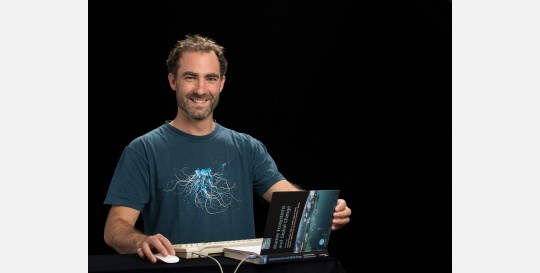Nathan Terseleer Lillo
Ecosystems Data Processing and Modelling (ECODAM)
Natural Environment

Nathan Terseleer is a marine ecosystem modeller who combines model development and data analysis to understand marine systems at high levels of detail. His research bridges plankton ecology and sediment dynamics, developing sophisticated numerical approaches to represent complex ecosystem dynamics and rich interactions between biological and mineral components across coastal to offshore water gradients.
Function
As a marine ecosystem modeller at the Royal Belgian Institute of Natural Sciences (RBINS), Nathan is developing the biogeochemical, plankton ecosystem, and organo-mineral particle interaction modules of the COHERENS model. He combines numerical modelling with advanced data analysis to improve our understanding of marine systems and their responses to anthropogenic pressures.
Research team: Ecosystem Modelling (ECOMOD)
Research theme: Science for a sustainable marine management
Area of Expertise
Nathan's expertise lies at the intersection of marine biogeochemistry, plankton ecology, and sediment dynamics. He specializes in process-based understanding of marine systems, particularly focusing on plankton functional diversity and organo-mineral interactions. His work combines mechanistic modelling approaches with statistical analyses of environmental data, supporting both fundamental research and applied marine management objectives. This integrated approach enables assessment and prediction of ecosystem responses to environmental changes and human pressures.
External activities
Nathan Terseleer is member of the ICES Working Group on Integrative, Physical-Biological, and Ecosystem Modelling (WGIPEM; and previous member of the Working Group on Harmful Algal Bloom Dynamics - WGHABD) and serves as an expert for the Marine Strategy Framework Directive (MSFD) in pelagic habitat assessment.
Beyond his professional activities, he co-founded a collective farming and co-housing project, developing collective intelligence skills he applies to facilitate effective scientific collaboration and team dynamics.
Professional Experience
Nathan Terseleer completed his PhD in marine ecosystem modelling at the Université Libre de Bruxelles (2009-2014), where he enhanced biogeochemical models by improving various aspects of diatom physiology and dynamics, including modelling of toxigenic species and trait-based approaches to represent functional diversity. At the Royal Belgian Institute of Natural Sciences, he contributed to the TILES project, which aimed at developing a decision support system for sustainable marine aggregate extraction, focusing on coupling detailed statistical seabed models with sediment transport modules and developing innovative algorithms for analyzing bathymetric data. Currently, in the BG-PART project (BELSPO), he investigates organo-mineral particle interactions at unprecedented levels of detail, advancing our understanding of these complex marine processes and their role in biogeochemical cycles.
Publication highlights
1. Desmit, X., Schartau, M., Riethmüller, R., Terseleer, N., Van der Zande, D., & Fettweis, M. (2024). The transition between coastal and offshore areas in the North Sea unraveled by suspended particle composition. Science of the Total Environment, 915, 169966.
2. Fettweis, M., Schartau, M., Desmit, X., Lee, B. J., Terseleer, N., Van der Zande, D., Parmentier, K., & Riethmüller, R. (2022). Organic matter composition of biomineral flocs and its influence on suspended particulate matter dynamics along a nearshore to offshore transect. Journal of Geophysical Research: Biogeosciences, 127(1), e2021JG006332.
3. Terseleer, N., Bruggeman, J., Lancelot, C., & Gypens, N. (2014). Trait‐based representation of diatom functional diversity in a plankton functional type model of the eutrophied southern North Sea. Limnology and Oceanography, 59(6), 1958-1972.
4. Terseleer, N., Gypens, N., & Lancelot, C. (2013). Factors controlling the production of domoic acid by Pseudo-nitzschia (Bacillariophyceae): A model study. Harmful Algae, 24, 45-53.
5. Montereale-Gavazzi, G., Roche, M., Lurton, X., Degrendele, K., Terseleer, N., & Van Lancker, V. (2018). Seafloor change detection using multibeam echosounder backscatter: case study on the Belgian part of the North Sea. Marine Geophysical Research, 39, 229-247.